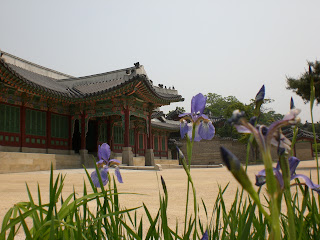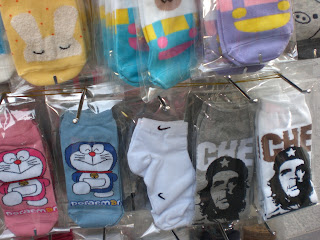
Remember SARS? The oh-so-scary avian flu that originated in Asia, and we were all afraid was going to infect the world, and result in the first post-global pandemic? The Newsweek cover photo with a woman in a paper mask still sticks out in my mind. Well, we survived it. Crisis averted.
But the Japanese haven't forgotten.
With the threat of Swine Flu growing, and the international health community on high alert, the Japanese took no risks with travelers entering Japan from North America.
Our flight to South Korea connected in Japan, which meant that we had to spend approximately one hour in Tokyo's airport before leaving for Incheon. Still, we had to go through the Japanese health screening process before we could leave the runway.
The man sitting next to me was from Michigan, on his way to China to do a tour with his MBA class. He said that one of the guys from his group who was from Mexico decided not to come on the trip at the last minute. He hadn't been home in a year, well before the emergence of the Swine Flu, but the Japanese health officials told him that if he tried to come through Japan they would quarantine him--for ten days.
When we boarded the plane, the stewardesses gave us health surveys. The surveyed asked if we had experienced any symptoms like coughing or sneezing recently, and it also asked us to include the seat numbers of any other passengers who might have been sick during the flight.
After we landed in Tokyo, health officials dressed in blue paper suits and masks boarded the plane. The officials who looked more like spacemen than surveyors went seat by seat asking passengers for their health questionnaires and taking everyone's temperatures with their thermoradar gun.
If for some reason a passenger's answer was questionable, or his or her temperature was too high they put a red dot on that person's seat and gave him or her a paper mask. Then they marked off four rows in front of his or her seat and gave each of those people a mask as well. It was like "Treasure Island" meets scary sci-fi flic.
Some members of our group were in the quarantined zones, but they managed to pass the final test. Only one person from our plane was taken to quarantine (ironically, he was not from North America, but from Japan). So, after sitting for almost an hour on the runway, we were cleared to enter the airport--just in time for all but one member of our group to make it to our connecting flight.
Domo arigato, Japan.
 We arrived during Yonsei's spring festival. Mechanical bull anyone? Photo by Erin Chapman.
We arrived during Yonsei's spring festival. Mechanical bull anyone? Photo by Erin Chapman. Korean truck stops are more like carnivals than truck stops. This little boy is eating fruit on a stick. Photo by Erin Chapman.
Korean truck stops are more like carnivals than truck stops. This little boy is eating fruit on a stick. Photo by Erin Chapman.  The steps in front of the Seoul National Art Museum. Photo by Erin Chapman.
The steps in front of the Seoul National Art Museum. Photo by Erin Chapman. The shrimp burger was not as good as the bulgolgi burger. Photo by Erin Chapman.
The shrimp burger was not as good as the bulgolgi burger. Photo by Erin Chapman.  South Korea is a place that truly appreciates musical theater. Consequently I love South Korea. Photo by Erin Chapman.
South Korea is a place that truly appreciates musical theater. Consequently I love South Korea. Photo by Erin Chapman. In Jeonju City we slept in a traditional Korean hut (aka on the floor with Spongebob blankets). Photo by Erin Chapman.
In Jeonju City we slept in a traditional Korean hut (aka on the floor with Spongebob blankets). Photo by Erin Chapman.  A young Korean couple sits in front of the light show above the Chungeychung river. Photo by Erin Chapman.
A young Korean couple sits in front of the light show above the Chungeychung river. Photo by Erin Chapman. 








































 Remember SARS? The oh-so-scary avian flu that originated in Asia, and we were all afraid was going to infect the world, and result in the first post-global pandemic? The Newsweek cover photo with a woman in a paper mask still sticks out in my mind. Well, we survived it. Crisis averted.
Remember SARS? The oh-so-scary avian flu that originated in Asia, and we were all afraid was going to infect the world, and result in the first post-global pandemic? The Newsweek cover photo with a woman in a paper mask still sticks out in my mind. Well, we survived it. Crisis averted. 